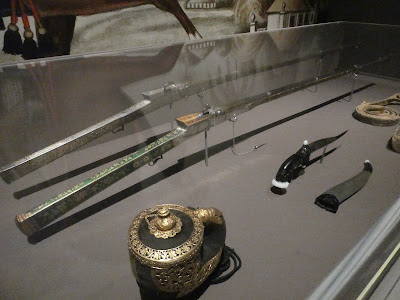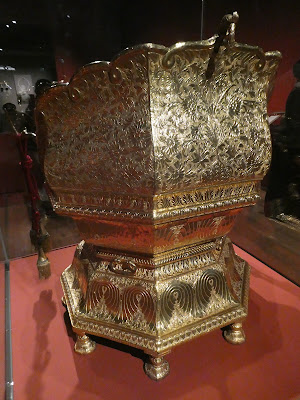On a rare sunny day, today I went to that London and visited The Wallace Collection, for their exhibition Ranjit Singh : Sikh Warrior King. And rather good it was, too.
Putting it very briefly, Maharaja Ranjit Singh lived from 1780 to 1839, and carved out a Sikh empire ('roughly the size of modern Germany') encompassing the Punjab, uniting many smaller Sikh states and building a powerful state which acted as a buffer between British possessionss in India and Afghan and Russian influence beyond the Khyber Pass.
He was a dynamic warrior, and developed a formidable army along modern Euopean lines, assisted by several Western soldiers, in particular former officers from Napoleonic France ( Ranjit Singh is sometimes referred to as 'The Napoleon of the East' as a result ). This army was designed to be more than a match for the forces of the East India Company, for example.
I knew very little of this period, but reviews of the exhibition looked interesting, and it proved to be well worth a visit. There were quite a few 'arms and armour' exhibits, many of which are reputed to have belonged to Ranjit Singh himself, and several interesting pictures involving military subjects, including one rather gory battle scene. I'll show some of the photos I took :
 |
 |
| Battle of Sirhind, 1710 |
The Sikhs had famously been a warrior race - the above picture illustrated that, showing a battle from 100 years before. In the centre, an enemy Mughal governor (riding the horse with its lower half dyed red) is pictured minus his head, which has been chopped off by a sword-weilding Sikh horseman. A version of the picture is also enlarged to cover the wall of one of the rooms, so you can see every gory detail.
There was a good selection of arms and armour associated with Ranjit Singh himself : swords, helmet, bow, pistol, musket. The pistol is interesting as its stock is of Indian make, but the lock is English; and the musket is interesting because despite the emphasis on modernity in the army, this personal weapon of the Maharaja is in fact a matchlock. Given some rather lovely metalwork decoration on it, I suspect this weapon was more for show than actual use!
This was a surprising exhibit - I had no idea that Quoits began as a battle weapon! The edges were sharpened, and they would be thrown at enemy formations - quite nasty. And they could be kept in a handy stack on the conical hat - where they then doubled as armour.
More Sikh helmets - note the way the wearer's top-knot is accommodated
Armour for a Sikh mounted warrior - note the rectangular plate armour, which was typical. There would be four plates strung toghether, making an all-round cuirass. Under that is a mail shirt.
More splendidly-engraved muskets, again matchlocks, with powder-horn and a dagger.
Contemporary picture of a mounted warrior of Ranjit Singh's army
Amritsar, home of the Sikhs' Golden Temple and part of Ranjit Singh's empire.
Portrait of Ranjit Singh in later life - 1830s. Note the Western style of the soldier's yellow jacket at the bottom.
Some of the 'Firanji' ( Foreigners ) who were brought in to modernise the army - first is a Frenchman, Jean-Francois Allard, who was a former officer in Napoleon's army, and was first commissioned to raise a corps of dragoons and lancers, being then made a General and becoming a close confidante of Ranjit Singh.
This splendid chap is Scots-American mercenary Alexander Gardner, who is of course wearing a tartan turban!
Gardner it seems wrote an eye-witness account of the political chaos after Ranjit Singh died in 1839, a rapid series of assassinations of his successors led to the empire's collapse and annexation by the British after what we refer to as The Sikh Wars. As a result of the British takeover, many of the riches of the Sikh empire passed to Britain, and of course are now able to be shown in this exhibition. Among the British loot was the Ko-ih-Noor diamond, and the show includes a document which is in effect a 'receipt' for it, presumably an attempt to legitimise its acquisition. There is also Ranjit Singh''s Golden Throne
The British governor, Lord Dalhousie, was ordered to send the throne to Britain, but rather took a fancy to it himself, and supposedly tried to have a replica made and sent, so he could keep the real one!
All in all quite a fascinating exhibition, and well worth a visit if the period is of interest. From a wargaming point of view, lots of inspiration, perhaps? The Sikh army did end up fighting against the British after Ranjit Singh's death - and a good 'what if' might be to imagine him actually getting into a scrap with the East India Company army while he was in his prime? Or with the Russians, perhaps if you also have a Crimean War force? The show will be quite timely if you have acquired Andy Copestake's recently published and doubtless excellent Khalsa! A Guide to Wargaming the Anglo-Sikh Wars 1845-1846 and 1848-1849
Finally a view of one of the exhibition rooms - the enlargement of pictures to cover entire walls is very effective. Using my National Art Pass discount, my ticket cost me £7, which was pretty good - normal price £14, though I suspect some might think the exhibition a little too small for that price. There are 'over 100' objects on display.
It's also woth noting that the Wallace Collection itself is a rather amazing
place, including a couple of rooms packed full of great arms and armour from Europe
and Asia, and a reallyfine collection of paintings and objets dart. It's like a sort of Mini V&A,
and a madly over-the-top Victorian house interior absolutely rammed with
'stuff' -the phrase 'Tart's Boudoir' springs to mind, in the nicest
possible way! I made a resolution to go back and spend an afternoon looking at the regualr collections - all this is 5 minutes from Oxford Street in Manchester Square, Central London. If you are interested in the period and find yourself in the area, I would thoroughly recommend a visit. Meanwhile keep well, everyone.

















Excellent museum tour, David! Thank you for the wonderful exhibit photos. I have Russians waiting to fight Sikhs, Afghans, and British.
ReplyDeleteThanks Jon, I will be fascinated to see your version of 'The Great Game' - as a game!
DeleteI enjoyed seeing the pictures, thanks for sharing. I would second your recommendation of the Wallace Collection. It is a fascinating place to visit and has a rather nice cafe too.
ReplyDeleteAlan Tradgardland
Thank you, Alan. Yes indeed the Wallace is rather special (the arms and armour galleries are quite something) and the cafe looked good too - I will have to try it on my next visit..
DeleteInteresting stuff David! Should inspire your Sikh company!
ReplyDeleteYou may be interested in this blog....
https://youdonotknowthenorth.blogspot.com/search/label/Anglo-Sikh%20War
Neil
Thanks Neil, I admit my interest was probably influenced by recent 'recruiting' of Sikhs to my WW2 forces. That blog is interesting, nice to see representations of the 'Western' Sikh army that Ranjit Singh created.
DeleteA fine exhibition there David, so thanks for sharing:)! Our daughter loves the Wallace Collection and an easy walk from her workplace, so nice to be able to pop in for a gander during her lunchbreak. I love the diea of the 'what if?' of him fighting the HEIC, which has loads of potential. Not sure how I'd fell throwing those quoits if I didn't have some sturdy glove on...
ReplyDeleteThanks Steve, and that's very nice for your daughter, there's enough interest there for many a lunchtime! I think the 'what if' idea is interesting - how would the Sikh army have done if its dynamic founder had still been in command? The quoits were a real surprise!
DeleteCoincidentally, I used Ranjit Sigh as a leader of a group for Zona Alfa. I used a figure with turban from a free Warlord WW2 sprue. He's been successful until now. Must be something in the genes!
ReplyDeleteThanks Khusru, Ranjit Singh's spirit clearly lives on!
DeleteGreat post David - educational too. I am especially impressed by the military quoits - they didn't go as far as pointy conkers, I suppose?
ReplyDeleteThanks Tony, those quoits were rather amazing, I want to see someone incorporate a unit of them into a wargame army. As to the conkers, didn't some medieval knights have a sort of spiky metal ball on a chain, not so unlike a conker?!
DeleteInteresting tour David. I was tempted by the Anglo-Sikh Wars after reading Flashman and the Mountain of Light*. But decided that it would be too close to other horse and musket periods. For now.
ReplyDelete* Gardner is a key character in this: and it seems the truth about him is as strange as the fiction.
Thanks 'anonymous', I'd say it might be a good twist on horse and musket - presumably a British army could be used if you have one already, and then you'd only need to raise Ranjit Singh's exotic east/west variant army for an opponent..
DeleteThe gift shop at the Wallace collection included a book about Gardner, I think he lived into the 1870s and had many further adventures, and wrote a colourful memoir. Stranger than fiction, indeed...
Sorry, it’s Chris/Nundanket!
DeleteCertainly more varied in terms of uniforms etc. I suppose it’s a chance to use the rules for jezzails in WRG 1685-1845 rules!